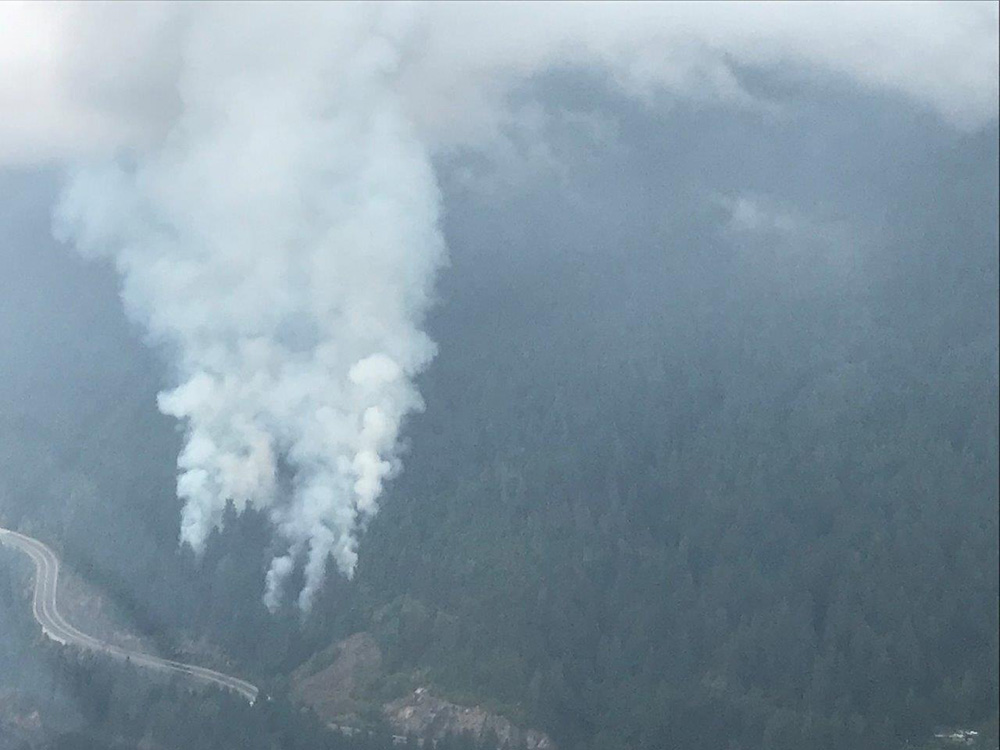Amanda Gray was heading south from her Squamish home early Sunday morning, driving her daughter to a swim meet. Just south of Lions Bay at Strip Creek, they saw dense clouds of smoke rising from roadside forest, and traffic slowed.
“You could see flames on the ground,” Gray said.
She immediately rolled up the windows and turned on the car’s air conditioning. Smoke is a serious health threat for Gray’s daughter.
“When the wildfires start in the summer, she’s stuck indoors because she had whooping cough when she was an infant and her lungs are damaged from it,” she said. “Everything needs to be all closed up.”
The fire is now 100-per-cent contained, but smoke from the blaze drifted over Vancouver.
Fires like the blaze that closed lanes on the Sea to Sky Highway may be the new normal for urban dwellers. The consequences include property damage and health risks, particularly for the almost 10 per cent of people who suffer from serious respiratory diseases.
The fire season is in its early stages, but the BC Wildfire Service already assesses the fire risk in southwestern B.C. as high to extreme.
The District of Squamish teamed up with the Resort Municipality of Whistler this year to develop an evacuation plan as both regions rely on the Sea to Sky Highway as an exit route. Projections from the plan include a potential 13-hour southbound evacuation time on a peak day.
That means the wildfire threat has increased for more densely populated — even urban areas — like North Vancouver, which is in the process of updating its evacuation plans.
‘A reality we will have to face’
Brian Hutchinson, fire chief of the District of North Vancouver Fire and Rescue Services, said the region is responding to the increased threat.
“In the past, wildfires were something that occurred elsewhere,” said Hutchinson. “We always heard about them in the Interior and the north, but this is bringing it home for those of us who live in Metro Vancouver that this is a reality we will have to face locally.”
The development is challenging for fire crews that have traditionally responded to structure fires or grass fires in suburban areas.
As fire risks rise, forests beside populated areas become an increasing fire danger. “In our topography, and with the fuels we have on the North Shore, you can get fast-moving incidents occurring,” said Hutchinson.
Those are challenging for urban-based fire services, as the Strip Creek fired showed. Gray said when she drove past the fire scene it was clear first responders could do little.
“The fire trucks were all just waiting around because there was nothing they could do,” Gray said. “The main blaze was up in the mountain.”
BC Wildfire Service information officer Kyla Fraser said it is better equipped to handle fires in vegetation, forests and grassy areas. The service assisted at the Strip Creek fire, along with the Lions Bay and West Vancouver fire departments, the RCMP and various administrative transportation bodies.
The service is responsible for responding to fires on Crown land and assisting municipalities with their fire response efforts.
Threat on the North Shore
Wildfires burned a record 13,540 square kilometres in B.C. last year, equivalent to about five times the area of Metro Vancouver.
Hutchinson said this is becoming the new normal as B.C.’s summers become hotter and drier with climate change — evidence of which is only getting stronger.
And while remote fires can be managed, or left to burn themselves out, areas like Metro Vancouver’s North Shore combine urban dwellings and heavily forested areas in a wildland-urban interface.
The consequences of fires in these areas have been shown in Fort McMurray and Kelowna.
Fiona Dercole, director of North Shore Emergency Management, said the District of North Vancouver has been assessing the risk and working to manage forests to reduce the fuel for wildfires. It’s targeted the most at-risk areas, she said.
“They’ve been thinning the forest in the areas that are of highest concern to create a contiguous shaded fuel break along the wildland-urban interface,” said Dercole.
“Basically, they keep the large trees that provide shade, but remove the dead and dry ladder fuels — which are like the spindly bits of tree branches that aren’t getting enough light to really thrive.”
The district has been removing debris on the forest floor that can become dry and fuel wildfires, she said.
Preparing for the worst
Dercole said the dramatic increase in the severity of B.C.’s wildfires has prompted the North Shore to update its evacuation plan.
“We’re just scoping it out right now,” she said. “But we’ve met with the transportation planner. The idea is to further identify the neighbourhoods that are at risk from changing hazards like wildfire, and estimate the amount of time it will require to evacuate those neighbourhoods.”
Dercole said that more remote communities pose a serious challenge.
The Woodlands Sunshine neighbourhood in North Vancouver, with its $3-million homes, is just a 15-minute drive from Deep Cove.
And wildfires pose a serious danger. “There’s only one road,” notes Dercole, creating a risk for residents if there is a fire.
The Grousewoods neighbourhood, at the foot of Grouse Mountain, is another challenging area, Dercole said, as Nancy Greene Way is the “only major route that goes up there.”
View Larger Map
Hutchinson notes other areas of Indian Arm can only be accessed by water, adding more complexity to potential evacuations.
The challenge isn’t just getting people out of areas threatened by fire, he said. “When you’ve got responders trying to get into an area, and you’ve got people leaving an area who haven’t been provided the appropriate amount of notice, then that can cause additional issues.”
Dercole said plans are in place to notify North Shore residents of an evacuation notice or order through radio, TV, social media, the phone-based alert system Rapid Notify and door-to-door notification.
But people need to do their part, said Dercole, Hutchinson and Fraser. Life in the wildfire interface zone today requires preparation — staying informed, having a grab-and-go bag and knowing the routes out of your community.
Even in urban centres. ![]()
Read more: Housing, Environment
















Tyee Commenting Guidelines
Comments that violate guidelines risk being deleted, and violations may result in a temporary or permanent user ban. Maintain the spirit of good conversation to stay in the discussion.
*Please note The Tyee is not a forum for spreading misinformation about COVID-19, denying its existence or minimizing its risk to public health.
Do:
Do not: